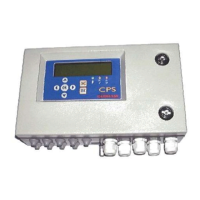Sensor module fault
In the event of a sensor module fault, gas levels are no longer taken into account, and all alarms are
cancelled, except for the negative threshold (or fault) which is activated. Average values are no longer
taken into consideration and the calculation of average values is paused.
If a sensor faults, it can be replaced while the central controller is still running (hot swap)
without replacing the detector.
Detector settings
The following settings apply to each type of detector:
▪ The abbreviated name to be displayed on the central controller: NO, CO, CO
2
…
▪ The name of the gas: Carbon monoxide, Nitric oxide, Oxygen, Methane …
▪ Unit: ppm, LEL, %v/v …
▪ Range with display format: 100, 10.0, 1.00, …
▪ Actionable thresholds:
o 4 instantaneous thresholds: 0-100% measuring range,
o 4 averaged thresholds : 0-100% measuring range, (time interval programmable from 1 to
480 minutes).
If the operating time is inferior to the averaging time interval, the averaging time interval is ignored.
An instantaneous threshold is associated with an averaged threshold to generate an alarm. These two
thresholds can be set to trigger on the rising edge (increasing alarm) or the falling edge (decreasing
alarm).
▪ Alarm delays ( 0s to 60 min ):
Each of the 4 alarm thresholds can be delayed. If gas levels are in excess of an alarm threshold for an
amount of time inferior to the programmed delay, the alarm will not activate.
The alarms can be acknowledged automatically once the alarm is turned off, or manually when the
gas levels are once again under the threshold.
▪ Fault thresholds:
o “underscale” negative signal (exceeding the lower threshold): -10% of the range.
o “SUP” out of range (exceeding the upper threshold): +120% of the range.
o “Verification” for all explosive gas sensors, in case an LEL threshold is passed, the SUP
alarm remains on even after levels fall under the threshold. The fault alarm is also triggered.
▪ Hysteresis:
Max. 1% of range. Default value = 0%.
Example (see opposite page):
Measurement range = 300 ppm; Alarm = 100 ppm;
Hysteresis (1% of range) = 3 ppm
Level at which alarm can be dismissed = 97

